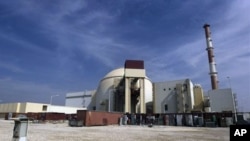Iran has finished building its first nuclear power plant, at Bushehr, on the coast of the Persian Gulf. It is expected to be operational later this year. In this second segment of our Nuclear Safety series, we look at the design and construction of Bushehr, and how this facility differs from the Japanese nuclear plant at Fukushima that has suffered major damage in the wake of a massive earthquake.
Northern Japan's massive March 11 earthquake and tsunami left the Fukushima nuclear power plant unable to run its cooling pumps and other safety systems. Within days, three buildings housing nuclear reactors suffered major explosions. And, radiation has been released.
Japan is well-known for earthquakes. Its nuclear power industry has said earthquake safety was included in its facility designs. But recent events have shown that the best of plans sometimes cannot overcome the forces of nature.
Half a world away, another country, Iran, is also well known for earthquakes. Over the years, tens of thousands of people there have died in massive tremors.
Now, Iran is moving into the nuclear age. Its first nuclear power plant, located at Bushehr on the Persian Gulf coast, has been completed. It could begin operating soon.
Construction of Bushehr began in 1974, but was halted by the 1979 Islamic Revolution. The plant was attacked and damaged in the eight year Iran-Iraq war. Construction finally resumed in 1995, with Russia taking over from the German company Siemens.
Engineering Professor Muhammad Sahimi, at the University of Southern California, says the threat of earthquakes was carefully considered when the location was selected.
"The first thing the Atomic Energy Organization of Iran did was extensive studies in terms of the safety of a nuclear reactor from the perspective of earthquakes," noted Sahimi. "Usually, a nuclear reactor is built in an area where the possibility of a major earthquake is very small. As far as I know, there is no major active fault in southern Iran where the Bushehr reactor has been built."
The single Russian VVER-1000 reactor installed at Bushehr, with roughly 1,000 megawatts power output, is comparable to its western counterparts.
Senior nuclear scientist Upendra Rohatgi at the U.S. government's Brookhaven National Laboratory in New York is very familiar with this type of reactor.
"The VVER-1000 is the latest Russian design, which is equal to western designs for pressurized water reactors," noted Rohatgi. "They all have the same safety systems, VVER and the western side [designs], and they all have very good containment systems."
Bushehr's reactor is a completely different design from the much older type that exploded at Chernobyl, Ukraine in 1986. The Iranian reactor, unlike the ones at Chernobyl, is completely encased in a massive concrete and steel containment vessel.
The containment vessel is designed to keep radiation from contaminating the environment should an accident take place. It has multiple layers to provide that protection, as well as strength to stop an impact or explosion from either inside or outside the structure.
Japan's Fukushima nuclear plant has a similar multiple-layer design. But there are fears that despite the design, at least one reactor containment vessel may have been breached. That, observers say, would account for at least some of the radiation that has been released.
In the next segment of this series, we'll take a look at the operational and safety training of nuclear plant workers, including those at Bushehr. Click here for part 1.













